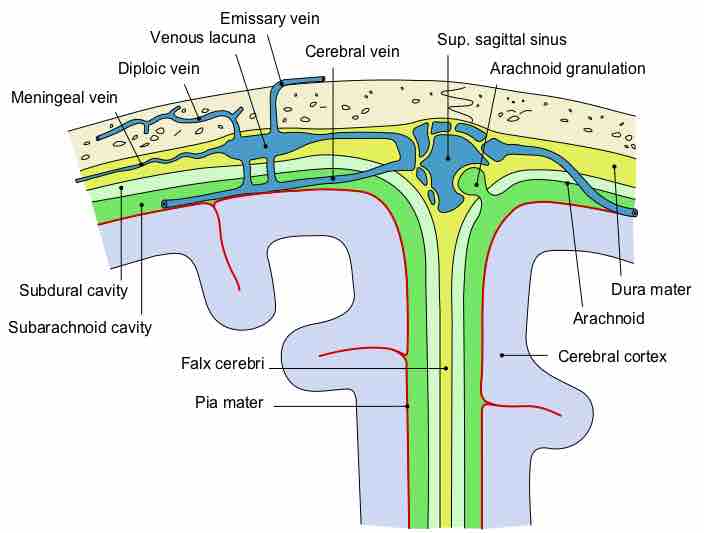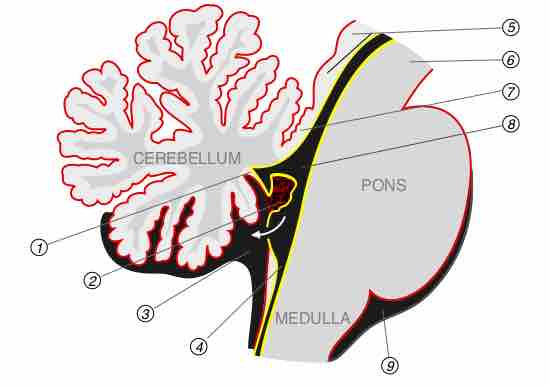Cerebrospinal fluid (CSF) is a clear, colorless bodily fluid that occupies the subarachnoid space and the ventricular system around and inside the brain and spinal cord. The CSF occupies the space between the arachnoid mater (the middle layer of the brain cover, the meninges) and the pia mater (the layer of the meninges closest to the brain). It constitutes the content of all intracerebral ventricles, cisterns, and sulci (singular sulcus), as well as the central canal of the spinal cord. It acts as a cushion or buffer for the cortex, providing a basic mechanical and immunological protection for the brain inside the skull and serving a vital function in cerebral autoregulation of cerebral blood flow.
CSF Production
Between 50 to 70% of CSF is produced in the brain by modified ependymal cells in the choroid plexus, and the remainder is formed around blood vessels and along ventricular walls. It circulates from the lateral ventricles to the foramen of Monro (interventricular foramen), third ventricle, aqueduct of Sylvius (cerebral aqueduct), fourth ventricle, foramen of Magendie (median aperture), foramen of Luschka (lateral apertures), and the subarachnoid space over the brain and the spinal cord. CSF is reabsorbed into venous sinus blood via arachnoid granulations.

Subarachnoid Cavity
Diagrammatic representation of a section across the top of the skull, showing the membranes of the brain with the subarachnoid cavity visible on the left.

The Choroid Plexus
This diagram indicates the (1) posterior medullary velum (2) choroid plexus (3) cisterna cerebellomedullaris of subarachnoid cavity (4) central canal (5) corpora quadrigemina (6) cerebral peduncle (7) anterior medullary velum (8) ependymal lining of ventricle (9) cisterna pontis of subarachnoid cavity
CSF is produced at a rate of 500 ml/day. Since the subarachnoid space around the brain and spinal cord can contain only 135 to 150 ml, large amounts are drained into the blood through arachnoid granulations in the superior sagittal sinus. Thus, the CSF turns over about 3.7 times a day. This continuous flow into the venous system dilutes the concentration of larger, lipid-insoluble molecules penetrating the brain and CSF. The CSF contains approximately 0.3% plasma proteins, or approximately 15 to 40 mg/dL, depending on the sampling site.
Functions of CSF
The functions of CSF include:
- Buoyancy: The actual mass of the human brain is about 1400 grams; however, the net weight of the brain suspended in the CSF is equivalent to a mass of 25 grams. The brain therefore exists in neutral buoyancy, which allows the brain to maintain its density without being impaired by its own weight.
- Protection: CSF protects the brain tissue from injury when jolted or hit.
- Chemical stability: CSF flows throughout the inner ventricular system in the brain and is absorbed back into the bloodstream, rinsing the metabolic waste from the central nervous system (CNS) through the blood-brain barrier. This allows for homeostatic regulation of the distribution of neuroendocrine factors, to which slight changes can cause problems or damage to the nervous system.
- Prevention of brain ischemia: Decreasing the amount of CSF in the limited space inside the skull decreases total intracranial pressure and facilitates blood perfusion.
- Clearing waste: CSF has been shown by the research group of Maiken Nedergaard to be critical in the brain's glymphatic system, the functional waste clearance pathway for the vertebrate CNS.
CSF as a Diagnostic Tool
When CSF pressure is elevated, cerebral blood flow may be constricted. When disorders of CSF flow occur, they may therefore affect not only CSF movement but also craniospinal compliance and intracranial blood flow, with subsequent neuronal and glial vulnerabilities. The venous system is also important in this equation.
CSF can be tested for the diagnosis of various neurological diseases, usually with a procedure called lumbar puncture. Lumbar puncture is performed in an attempt to count the cells in the fluid and to detect the levels of protein and glucose. These parameters alone may be extremely beneficial in the diagnosis of subarachnoid hemorrhage and CNS infections such as meningitis. Moreover, a CSF culture examination may yield the microorganism that has caused the infection.